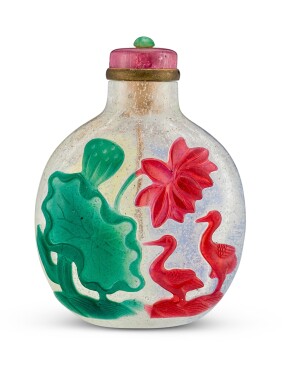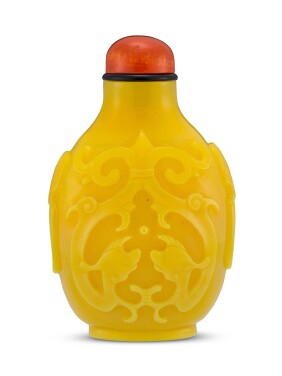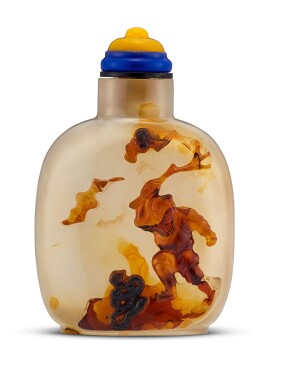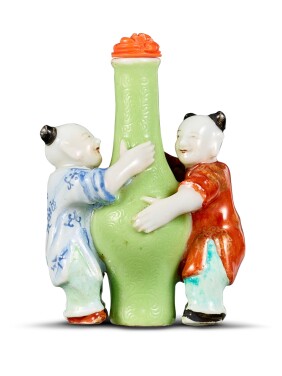I ntroduced to China in the late Ming to early Qing dynasty, snuff bottles captivated the attention of the upper classes, who were riveted by their intricate designs and functionality. Masterfully created by master craftsmen using a range of precious materials, such as jade and jadeite, agate, amber, porcelain, lacquer, and overlay glass, these delicate miniatures ingeniously encapsulated the deep-rooted artistic development throughout Chinese history.
Renowned for his keen passion for Chinese antiquities, the master of the Jimeng Shanfang has travelled the world and indefatigably searched for treasures for over 70 years. As an avid collector, he possesses a rich array of masterpieces, ranging from ceramics to paintings, and from jades to traditional scholarly accessories. The current auction presents a fine collection of 41 lots of magnificent snuff bottles, most of which are made of overlay glass, and have been exhibited at the Suzhou Museum.
An overlay glass snuff bottle comprises two or more colours. The workmanship entailed can be classified into two sorts, one of which begins with applying different layers of coloured glass above the main glass body, then skillfully carving through to create motifs and figures, whereas the other technique requires applying half-melted liquid glass directly from the rod to wind and delineate ornaments on the vessel-body. The famous Qing scholar Zhao Zhiqian, in his Yonglu Xianjie [Researches in Spare Time into the Realm of Yonglu, God of the Nose], praised “overlay glass comes in red and blue…from two, three, four, to five or even more superimposing layers of colours, exquisitely cast and formed. Designs from the Kangxi reign emerged so elegantly yet effortlessly, like objects of marvel. The composition became more elaborate over the Qianlong period, during which skilful craftsmen meticulously carved with their nimble fingers, decorating the vessels with auspicious creatures such as dragons, phoenixes, and chi [hornless dragons], as well as other common animals, such as geese and fish, against a flowery meadow and flowing river.” As per this account, the production of overlay glass snuff bottles originated in the Kangxi period, yet none of those have been discovered that one must conjecture and imagine from Zhao’s vivid description, in which designs from the Yongzheng and Qianlong periods are also recorded. The popularity of snuff bottles peaked during the Qianlong period, during which the practice of snuff-taking extended from the elite to the peasantry, giving rise to more contemporary designs from small folk workshops, and later becoming a unique genre in ancient Chinese works of art.

鼻煙壺,舶來之物,初譯為「士拿乎」。明末清初傳入中國,盛於清朝皇親貴冑之間,蔚為風尚。鼻煙壺小可盈握,方寸之間集中國藝術之大成,以珍貴材質如翡翠玉石、瑪瑙、琥珀、雕瓷、雕漆、套料等精雕細琢,無不精彩絕倫,盡顯工匠們的鬼斧神工。
楫夢山房主人,聞名中外,對中國文物情有獨鍾。潛心收藏七十餘載,門類廣泛,瓷器、書畫、玉器、文房雅玩,豐富精彩。他周遊世界,尋找心頭所好,有寶藏的地方,定見他們的身影。次場專拍,分享藏品共四十一件套,以玻璃煙壺為主,其中多為套料,大部分曾展於蘇州博物館。
套料是指由兩種以上顏色的玻璃製成的鼻煙壺。製作工藝分為兩種,一種是在料胎上滿套不同色料,再在外套的玻璃上雕琢紋飾;另一種是玻璃棒經加熱半熔,然後直接在胎上做紋飾。清代著名學者趙之謙著《勇廬閑詰》中寫道:「套之色有紅有藍……更有兼套二彩、三彩、四彩、五彩或重叠套,雕鏤精絕。康熙中所製,渾樸簡古,光艷照爛如異寶。乾隆以來,巧匠刻畫,遠過詹成,矩鑿所至,細入毫髮,捫之有棱。龍鳳盤螭,魚雁花草,山川彞鼎,千名百種,淵乎清妙。」據此記載,套料鼻煙壺始作於康熙,迄今為止雖未見康熙實物,但從字裏行間可以想像。雍正、乾隆朝均見套料鼻煙壺記載。乾隆朝鼻煙壺盛行,無論王公貴族或販夫走卒,皆嗜鼻煙,鼻煙壺製作擴展至民間作坊,百花齊放,成為中國古代藝術品中獨特的品種。


















